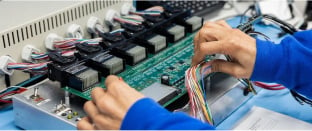If your company depends on electric forklifts, the type of battery you choose will have a major impact on your operations.
When it comes time to purchase a forklift battery - either because you’re updating your fleet or replacing a battery at the end of its life cycle - there are several factors you will need to take into consideration to ensure you choose the right one for your operation.
Below we’ll explore some of the specifications you should know when comparing your choices, as well as some of the major differences among battery options that can have a direct impact on efficiency and operational costs.
Battery Type Technology
One of the most important decisions you’ll have to make when purchasing a forklift battery is the type itself. Commercial forklifts generally are powered by either lead acid or lithium-ion batteries.
Lead acid batteries, considered the long-standing standard for forklifts, are usually heavier in weight than lithium-ion batteries of the same capacity. They are filled with electrolytes (sulfuric acid and water) and include a removable top. This type of battery generates electricity through a chemical reaction of lead plates and sulfuric acid. Lead acid batteries require regular refilling with water, or the chemical process will degrade and the battery will suffer an early failure.
Lithium-ion batteries are newer technology, and have many different chemistries. One of the most popular chemistries for the material handling industry is lithium-ion phosphate (LFP). This type of battery is more compact and energy dense than lead acid, and the cells are sealed shut, so no water maintenance is required.
A lithium-ion battery’s design provides several benefits, and perhaps most importantly, a safety component. Lithium-ion batteries don’t require dedicated rooms for charging and cooling, unlike lead acid batteries. Lead acid batteries also are prone to heating and dangerous fumes while charging.
You can read more about the benefits of lithium-ion technology in our article, Why Does A Lithium-Ion Battery Work Best For Forklifts?
Battery Voltage
Once you decide the type of electric battery technology you’re interested in implementing into your fleet, you’ll need to select a voltage. This specification is important because certain pieces of equipment require specific voltages to operate.
Generally speaking, there are four voltage options available for electric material handling equipment:
- 24-volt - typically used in smaller types of electric lift equipment, such as end riders, center riders, walkie stackers and electric walkie pallet jacks
- 36-volt - used for mid-sized electric equipment, such as narrow aisle forklifts
- 48-volt - used for large electric equipment, such as counterbalanced electric forklifts
- 80-volt - often used in large equipment, including counterbalanced forklifts and airport ground support equipment
You should also check the size of the compartment where the battery will be placed. This includes the width, height and length of the compartment - not the battery itself.
With your current equipment, it’s important to consult with the owner’s manual or manufacturer to determine the required voltage. If you use the wrong voltage, you could damage your equipment.
Weight
Before choosing a battery, it’s important to make sure it will fit in your particular piece of equipment.
Different forklift models have recommended battery weight requirements. Installing a battery that is lighter or heavier than what the manufacturer recommends could create a safety hazard because of counterbalance issues.
Charging Times
The charging time of a forklift battery is one of the most important specifications to consider.
Lithium-ion batteries feature remarkably fast charging times - something multi-shift operations can take advantage of. That’s because this type of battery has no memory effect, making partial charges possible. A typical charge and use cycle for a lithium-ion battery is 8 hours of use, 1 hour to charge and another 8 hours of use. No cooling period is needed.
On the other hand, lead acid batteries require nearly 8 hours of charging and 8 hours cooling down. That means two to three batteries are required with multi-shift operations, whereas for lithium-ion batteries, they can be used across multiple shifts through opportunity charging.
Charger Specifications
Make sure the type of battery you purchase aligns with the charging station you have or plan to install.
If you are purchasing new equipment altogether, a forklift battery charger system is a much bigger consideration than many business owners realize. Lead acid batteries have specific forklift battery charging station requirements that lithium-ion batteries do not.
Lead acid batteries must be completely removed from the vehicle and attached to a separate forklift battery charger. So, if you’re purchasing a lead acid battery, you’ll want to make sure the specifications align with the charger you have or plan to purchase. You’ll also need to ensure that a separate room is dedicated to charging for safety precautions, since lead acid batteries can get very hot while charging.
When charging lithium-ion batteries, there is no need to remove the battery from your equipment. Instead, they are plugged directly into a charger.
Bottom Line
Whether you are updating your fleet or replacing a battery that is at the end of its life cycle, there are several factors to consider before you commit to this significant purchase.
Knowing the specifications required for your current fleet is important before you begin searching. It is also important to know the benefits of each type of battery so you can choose which battery is better to meet your long-term goals.












